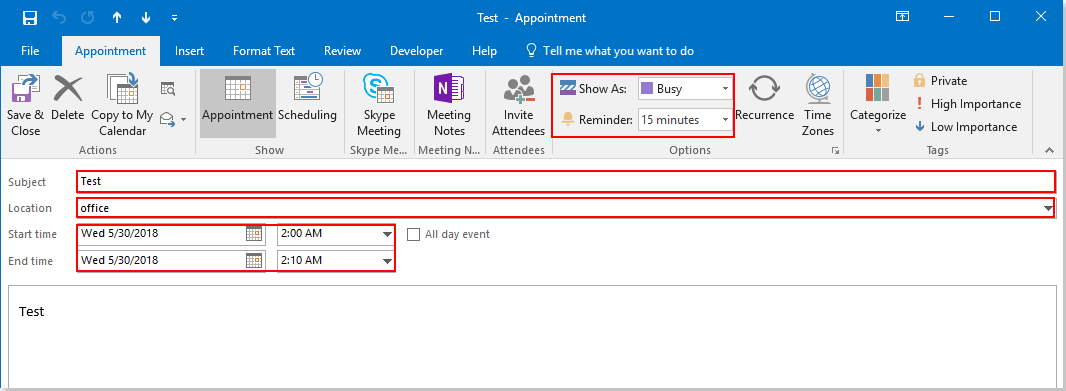Jak tworzyć przypomnienia programu Outlook z arkusza kalkulacyjnego Excel?
Ten artykuł dotyczy tworzenia przypomnień programu Outlook na podstawie danych z arkusza kalkulacyjnego Excel.
Kreta Outlooka przypomnienia z arkusza kalkulacyjnego Excel z kodem VBA
Twórz przypomnienia programu Outlook z arkusza kalkulacyjnego Excel z kodem VBA
Jeśli chcesz utworzyć przypomnienia programu Outlook z programu Excel, wykonaj następujące czynności.
1. Utwórz arkusz roboczy zawierający nagłówki kolumn i odpowiadające im pola przypomnień, jak pokazano poniżej.

Note: Dla stan zajęty kolumna, liczba 2 oznacza, że przypomnienie będzie wyświetlane jako Zajęty w kalendarzu Outlooka. Możesz to zmienić na 1 (Wstępnie), 3 (Poza biurem), 4 (Pracując gdzie indziej)lub 5 (bezpłatny) tak jak potrzebujesz.
2. wciśnij inny + F11 klawisze, aby otworzyć Microsoft Visual Basic for Applications okno.
3. w Microsoft Visual Basic for Applications okno, kliknij wstawka > Moduł. Następnie skopiuj poniższy kod VBA do okna Code.
Kod VBA: twórz przypomnienia programu Outlook z arkusza kalkulacyjnego Excel
Sub AddAppointments()
'Update by Extendoffice 20180608
Dim I As Long
Dim xRg As Range
Dim xOutApp As Object
Dim xOutItem As Object
Set xOutApp = CreateObject("Outlook.Application")
Set xRg = Range("A2:G2")
For I = 1 To xRg.Rows.Count
Set xOutItem = xOutApp.createitem(1)
Debug.Print xRg.Cells(I, 1).Value
xOutItem.Subject = xRg.Cells(I, 1).Value
xOutItem.Location = xRg.Cells(I, 2).Value
xOutItem.Start = xRg.Cells(I, 3).Value
xOutItem.Duration = xRg.Cells(I, 4).Value
If Trim(xRg.Cells(I, 5).Value) = "" Then
xOutItem.BusyStatus = 2
Else
xOutItem.BusyStatus = xRg.Cells(I, 5).Value
End If
If xRg.Cells(I, 6).Value > 0 Then
xOutItem.ReminderSet = True
xOutItem.ReminderMinutesBeforeStart = xRg.Cells(I, 6).Value
Else
xOutItem.ReminderSet = False
End If
xOutItem.Body = xRg.Cells(I, 7).Value
xOutItem.Save
Set xOutItem = Nothing
Next
Set xOutApp = Nothing
End SubNote: W powyższym kodzie, A2: G2 to zakres danych, na podstawie którego chcesz tworzyć spotkania.
4. wciśnij F5 lub kliknij przycisk Uruchom, aby uruchomić kod. Następnie wszystkie spotkania z określonymi polami zostaną jednocześnie wstawione do kalendarza programu Outlook.
A następnie możesz przejść do Kalendarza swojego programu Outlook, aby wyświetlić wyniki, Zobacz zrzut ekranu:

Najlepsze narzędzia biurowe
Kutools dla programu Outlook - Ponad 100 zaawansowanych funkcji, które usprawnią Twoje perspektywy
🤖 Asystent poczty AI: Natychmiastowe profesjonalne e-maile z magią AI — genialne odpowiedzi jednym kliknięciem, doskonały ton, biegła znajomość wielu języków. Zmień e-mailing bez wysiłku! ...
📧 Automatyzacja poczty e-mail: Poza biurem (dostępne dla POP i IMAP) / Zaplanuj wysyłanie wiadomości e-mail / Automatyczne CC/BCC według reguł podczas wysyłania wiadomości e-mail / Automatyczne przewijanie (Zasady zaawansowane) / Automatyczne dodawanie powitania / Automatycznie dziel wiadomości e-mail od wielu odbiorców na pojedyncze wiadomości ...
📨 Zarządzanie e-mail: Łatwe przywoływanie e-maili / Blokuj oszukańcze wiadomości e-mail według tematów i innych / Usuń zduplikowane wiadomości e-mail / Wiecej opcji / Konsoliduj foldery ...
📁 Załączniki Pro: Zapisz zbiorczo / Odłącz partię / Kompresuj wsadowo / Automatyczne zapisywanie / Automatyczne odłączanie / Automatyczna kompresja ...
🌟 Magia interfejsu: 😊Więcej ładnych i fajnych emotikonów / Zwiększ produktywność programu Outlook dzięki widokom na kartach / Zminimalizuj program Outlook zamiast go zamykać ...
>> Cuda jednym kliknięciem: Odpowiedz wszystkim, dodając przychodzące załączniki / E-maile chroniące przed phishingiem / 🕘Pokaż strefę czasową nadawcy ...
👩🏼🤝👩🏻 Kontakty i kalendarz: Grupowe dodawanie kontaktów z wybranych e-maili / Podziel grupę kontaktów na pojedyncze grupy / Usuń przypomnienia o urodzinach ...
O Cechy 100 Poczekaj na eksplorację! Kliknij tutaj, aby dowiedzieć się więcej.

